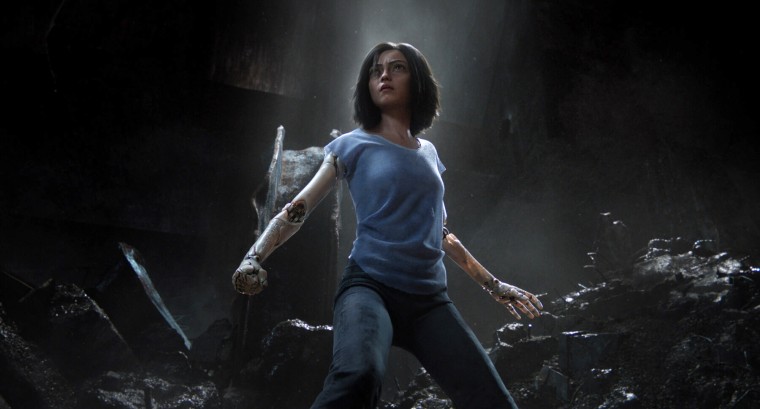Finally freed from scourge of “Fifty Shades” Valentine’s Day releases, this year’s romantic offerings are more sardonic (“What Men Want” and “Isn’t It Romantic”). But the highest-profile release this week isn’t a rom-com. “Alita: Battle Angel,” produced and co-written by James Cameron, is a genre-hopping whirlwind of an epic, encompassing a coming-of-age story, an apocalyptic future and a very dangerous sport. Like other recent Cameron epics, “Alita” is a lot. It’s ridiculously ambitious. It’s gorgeous to look at, a technical marvel of a film that mixes digital and human characters into a single frame. It’s just too bad the main plot isn’t worthy of all the innovation.
Like other recent Cameron epics, “Alita” is a lot. It’s gorgeous to look at, a technical marvel of a film that mixes digital and human characters into a single frame.
The story of “Alita” is taken from a Japanese cyberpunk manga series known as “Gunnm,” published in 1990. (The literal translation of the title is “Gun Dream.”) After the first two volumes were turned into anime features, the series was dubbed in English and retitled first “Battle Angel” and then “Battle Angel Alita.” In a recent interview with the Associated Press, Cameron claims to have been working to bring this story to the big screen since his “Titanic” days, when he was first introduced to the comic.
The world of “Alita” is expertly created, a fascinating, post-apocalyptic landscape in the 26th century. Iron City inhabitants work and scrabble to find a way to the floating gentrified world of Zalem that hovers above them. Mostly digital, both Iron City and Zalem feel wondrously real and inhabitable. Cameron’s ability to make Alita, an animated creation, hold her own while “acting” alongside very alive A-list Hollywood talent like Christoph Waltz, Jennifer Connelly and Mahershala Ali is equally impressive.
There’s a reason the newfangled performance-capture technology isn’t typically used for characters who are or who appear human. (Video games highlight how difficult it is to render human faces realistically.) It’s one thing to create the fictional Na'vi this way in “Avatar.” There’s nothing in the human world to compare them to. Even characters like Caesar in “Planet of The Apes” don’t have to be perfect, because many moviegoers have watched the progression of technology from film to film. But human faces are something moviegoers see every day, with their constant muscle movements expressing complex emotional and physical signals. This is why, even now, when cyborg and robot characters are shown on screen, there’s usually a human actor behind the CGI.
SIGN UP FOR THE THINK WEEKLY NEWSLETTER HERE
Not here. The star of “Alita,” Rosa Salazar, is completely obliterated, replaced wholesale with the digitalized Alita. And for nearly the entire movie, it’s easy to forget Alita, giant eyes and all, isn’t an actual person standing beside Waltz or her one true love Hugo (Keean Johnson.) Though the eyes have drawn complaints from several quarters, including reviewers and Twitter fans, they’re actually an extremely clever choice that redirect focus away from the rest of the face and compensate for other features that may fail to render human expressions as perfectly.
Cameron’s name and clout in Hollywood were instrumental in getting the film made, but this is not his film alone. It was written in partnership with Laeta Kalogridis, who was the brains behind Netflix’s ultra-violent “Altered Carbon” last year and directed by Robert Rodriguez, who has helmed hits from “Sin City” to “Spy Kids.”
Sadly, having a female voice in the scripting process did not prevent a seeming cluelessness about how a female protagonist might react in various situations. As realistic as Alita may seem while fighting with Mahershala Ali’s bad guy Vector, she’s a disappointing heroine. Her continued infatuation with Hugo is both unbelievable and vaguely irritating. Her “rebellion” against her father lacks emotional depth, feeling more like something a guy might encourage his teenage girlfriend to do in order to get into her pants. When Alita changes cyborg bodies after her first one is broken, the way the camera leers over her sudden boobs and hips is plain old icky.
“Alita” mostly fails when it attempts to talk about puberty and romance from a girl’s point of view. The film is most coherent, on the other hand, as an action adventure story starring Alita as the hero tasked with bringing down Zalem’s evil overlord. The Motorball scenes are also impressive, if sometimes jarring. Rodriguez does his best work directing the competitions, which also include some of the most suspenseful fight sequences of the entire film. Unfortunately, none of these elements are granted a satisfying conclusion, with the film’s ending clearly prepping for a sequel.
When it comes to the technical parts of “Alita,” fans of Cameron are going to get their money’s worth. This is the rare movie that’s actually worth seeing in 3D. In part for this reason, it may also break a few box office records while it’s out. I just wish the production had focused more on storytelling. Cameron has pushed the boundaries of what digitally created female heroes can look like — if only he’d put the same amount of thought into pushing the limits of who they can be.

